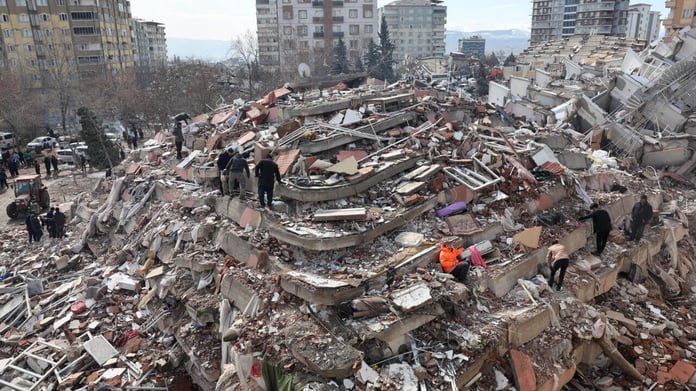A few hours after the first earthquake of magnitude 7.8 which hit the region on the border between Turkey and Syria on Monday, a second quake of similar intensity occurred. A tremor that was somewhat quickly assimilated to an aftershock when it is a different and much rarer phenomenon.
Coming nine hours after the main tremor, it first took the scientific community by surprise. An “aftershock” of magnitude 7.5 wreaked havoc only a few dozen kilometers from the epicenter of the first earthquake of magnitude 7.8, which occurred on Monday February 6 on the border between Turkey and Syria.
A second earthquake of such intensity does not fit well with what we know about aftershocks. “There is a scaling law with earthquakes, called Omori’s law, which provides that in the event of an earthquake of a certain magnitude, there will be, to simplify, a first aftershock about ten times smaller, then ten aftershocks a hundred times smaller and so on”, explains Christophe Vigny, seismologist at the geology laboratory of the École Normale Supérieure (ENS).
“Triggered earthquake” or “doublet”
The second tremor on the Turkish-Syrian border would therefore defy the laws of seismology with its violence. Except that in reality it is not a replica. This is another phenomenon, called “triggered earthquake” or “doublet”: that is to say a second earthquake directly caused by the first.
This type of earthquake that follows the main shock is “infrequent, but has already been observed in the past”, specifies researcher Christophe Vigny.
The main difference with an aftershock is that “a doublet does not occur on the same geological structure”, underlines Thomas Lecocq, seismologist at the seismology and gravimetry center of the Royal Observatory of Belgium. In this case, the second shock took place on a secondary fault, a little north of the East Anatolian fault responsible for the main shock.
With triggered earthquakes, there are no rules as with aftershocks. The latter are sorts of echoes which gradually diminish, whereas the “doublets” are collateral shocks which have their own dynamics. Nothing therefore prevents them from being as powerful or almost as the main earthquake.
The main event doesn’t even have to be very strong to cause a triggered earthquake. A medium earthquake “can result in a doublet. What is most important is that the secondary fault is in a state close to rupture”, notes Belgian seismologist Thomas Lecocq.
As such, the area where the earthquakes struck was a good candidate for such a rare phenomenon. There is, in fact, “a significant patchwork of faults deemed close to rupture”, adds the seismologist from the Royal Observatory of Belgium.
It is also necessary that this collateral shock is not too far from the epicentre. “There is no precise rule, but we can say that at a distance greater than a hundred kilometers, we have not yet recorded a triggered earthquake”, notes ENS researcher Christophe Vigny.
On the other hand, nothing indicates that a doublet will intervene quickly after the first shock. There are two main scenarios. “If the doublet was caused by the vibrations of the shock, it will be triggered in the wake of the first earthquake”, underlines Thomas Lecocq. But there may also be more complex mechanisms at work – in particular the circulation of fluids in the rock – which can lead to “triggered earthquakes occurring months or even years later”, underlines Christophe Vigny.
Risk of domino effect?
The differences between triggered earthquakes and aftershocks are not only of the order of geological detail. The doublets “have their own sequences with their own replicas”, emphasizes Thomas Lecocq of the Royal Observatory of Belgium.
It is partly because there was a powerful earthquake triggered and not just aftershocks of a single earthquake that the damage was so extensive on the border between Turkey and Syria .
This seismic event could still know other chapters. “There can in theory be a domino effect”, recognizes the Frenchman Christophe Vigny. There are other examples of earthquake cascades like in Sumatra. There was the historic earthquake followed by the tsunami in the Indian Ocean in 2004, then “another earthquake in 2005, and in 2006, until 2010”, underlines the seismologist of the ENS.
Problem: there’s no way to tell if a similar scenario is unfolding. “We know how to calculate by how much the main shock will increase the stress on the neighboring faults. But there is no certainty as to whether this additional pressure will lead to other triggered earthquakes”, concludes Christophe Vigny.
If so, it is also not possible to predict where potential doublets might occur. The epicenter of the first quake is at a bend in the Eastern Anatolia Fault, and it continues in two directions: on one side towards Israel and Lebanon and towards Cyprus on the other.


